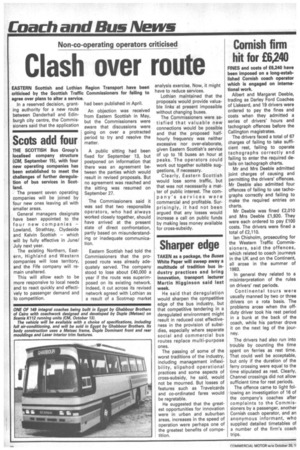Non-co-operating operators criticised
Page 28

If you've noticed an error in this article please click here to report it so we can fix it.
Clash over route
EASTERN Scottish and Lothian Region Transport have been criticised by the Scottish Traffic Commissioners for failing to agree over plans to alter a service.
In a reserved decision, granthad been published in April.
ing authority for a new route between Danderhall and Edinburgh city centre, the Commissioners said that the application An objection was received from Eastern Scottish in May, but the Commissioners were aware that discussions were going on over a protracted period to try and resolve the matter.
A public sitting had been fixed for September 13, but postponed on information that there was an agreement between the parties which would result in revised proposals. But no agreement was reached and the sitting was resumed on September 27.
The Commissioners said it was sad that two responsible operators, who had always worked closely together, should have arrived at the present state of direct confrontation, partly based on misunderstanding or inadequate communication.
Eastern Scottish had told the Commissioners that the proposed route was already adequately served. The company stood to lose about £40,000 a year if the route was superimposed on its existing network. Indeed, it cut across its revised network agreed with Lothian as a result of a Scotmap market analysis exercise. Now, it might have to reduce services.
Lothian maintained that the proposals would provide valuable links at present impossible without changing buses.
The Commissioners were satisfied that valuable new connections would be possible and that the proposed halfhourly frequency was neither excessive nor over-elaborate, given Eastern Scottish's service of up to 16 buses an hour at peaks. The operators could work out together suitable suggestions, if necessary.
Clearly, Eastern Scottish would lose some traffic, but that was not necessarily a matter of public interest. The company's services were commercial and profitable. Surprisingly, it had not been argued that any losses would increase a call on public funds by making less money available for cross-subsidy.
































































































































































































































